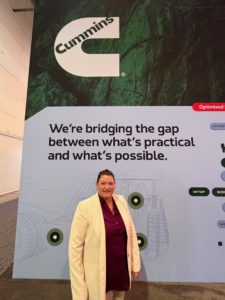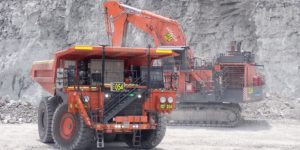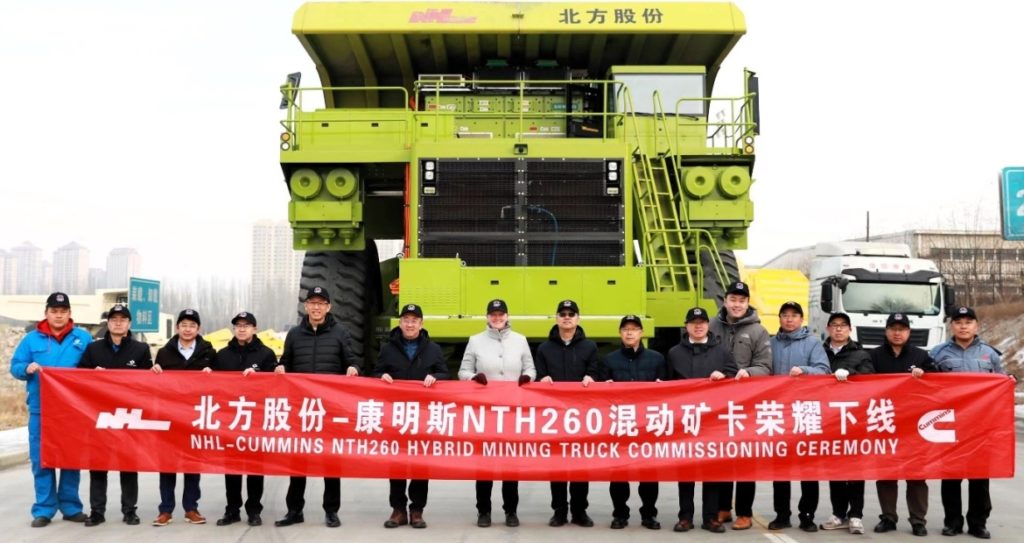Cummins is globally known as a leader in mining engines used throughout the world on mining trucks and excavators, including all Komatsu mining machines. Its QSK50, QSK60 and QSK78 engines are renowned for their performance across all mining types and conditions, such as high altitude and temperature extremes. But of course Cummins, like its customers, is looking to the future and options on the route to net zero.
During MINExpo 2024, IM Editorial Director Paul Moore sat down with Molly Puga, Cummins Power Systems Executive Director of Strategy, Digital and Product Planning, to talk about just that.
Molly Puga, Cummins Power Systems Executive Director of Strategy, Digital and Product Planning

“Our view is that eventually, zero carbon solutions make sense for mining. If you look at Cummins as a corporation, we have a large on-highway business and have invested a lot in batteries and battery technology, as well as hydrogen, related to that. One reason for that is that the adoption curve in on-highway is coming much more quickly. So to date all of our major zero carbon investments organically have been in that sector. As we think about mining, our view is that battery electric vehicles are the most likely technology end state, but that there are a lot of practicalities, especially related to energy distribution and charging infrastructure plus the capital involved in things like overhead catenary lines, fast chargers, etc., that make it not necessarily the most pragmatic solution for now. Plus, even looking at that end state, there are some mines which lend themselves well to electrification and some which don’t; it depends on your ability to get enough power to the mine site.”
There are always early adopters and slow adopters, plus Puga pointed out there is still a vast swathe of the mining sector that is still using sub-Tier 4 Final engines, so there are still huge emissions wins to be had from that process panning out as well. Plus, as of 2023, all Cummins high-horsepower engines are approved for unblended use with 100% HVO, allowing miners to utilise renewable diesel, generating emissions saving while maintaining power output.
Similar to the truck OEMs, Cummins believes that multiple technologies will play a role in the mining powertrain of the future and that there will be no one size fits all. “Miners are looking at some of these solutions but some are moving faster, often based on pressure from investors and how they have set interim decarbonisation targets and ESG goals. Some of these are being aggressive with interim 2030 targets so are trying to make big moves now; others are more focused on 2050 net zero and seeing what the next decade brings.”
Upgrading to the latest Cummins engine technologies, such as these examples at Rio Tinto and Whitehaven Coal, allow customers to benefit from big emissions wins today


Cummins’ strategy is two pathways to decarbonise: “First there is an electrification pathway that starts ideally with an existing diesel-electric powertrain, adding a battery to create a hybrid stepping stone solution, then eventually you remove the engine and have an all battery powertrain.”
Cummins has already succeeded in demonstrating a hybrid step – in March a hybrid NHL NTH260, 220 t mining truck rolled off the production line in Baotou and is running at Baiyun Iron Mine. The Cummins’ optimised hybrid system allowed the truck engine to be downsized from the previous 2,500HP QSK60 to the current 2,000HP two-stage QSK50. Cummins also supplied power electronics, the battery module and the integration across the powertrain. Cummins says advanced hybrids have the potential to improve fuel efficiency up to 30% dependent on the mine profile and advanced battery technology and controls integration.
Puga adds: “Our strategy is to create modular building blocks that allow you to make the same architecture choices to allow for this route to eventual electrification with the minimal amount of tear up required on the vehicle as possible. Plus, if you wanted to make one of the step changes as part of a major engine rebuild or overhaul – you could do that. That means you could retrofit a truck already out there with a retrofit hybrid kit and get some emissions reductions now as well as fuel savings.”
The second Cummins pathway centres on alternative fuels. “This depends somewhat on where you are in the world. If you are in a region with natural abundance of ethanol or methanol, which are carbon lowering fuels, this can mean minimal interference with the existing engine – for example you could use a dual fuel kit, which is what we are doing with Komatsu and Vale using ethanol in Brazil. And once you start using alcohol-based fuels – it puts you on a pathway towards hydrogen if that becomes a fully scaled solution.”
Cummins is investing in both pathways. Puga adds: “Miners want solutions now to help them make progress. While many OEMs are focusing on going straight from diesel to full BEV, we at Cummins are hearing from miners that they need to show some significant progress now and that they can’t wait for full BEV to be available or indeed commercial from a productivity point of view. Looking at the mines today, you have a whole existing installed base of trucks with turnover of 8-10% a year. So, you can either scrap whole fleets before their scheduled retirement and start again at huge cost, or look to progressively decarbonise with bridge solutions then you get decarbonisation benefits on those trucks still running until their scheduled replacement without massive extra cost.”
The NHL hybrid truck, despite being a prototype is already yielding 15-20% fuel savings at Baiyun. “Other players planning to bring out hybrids are speculating on potential savings – we are showing it is the case and have the real mine field data to prove it.” While the NHL hybrid was a first fitment in the factory, the design is also retrofittable. Puga: “For me the key value for hybrid is that it offers maximum uptime and lower cost of operation while bringing the emissions wins. If hybrids unlock 30% fuel savings this directly translates to major emissions cuts today. This makes the business case for investing in it much easier. Other solutions out there do not hit the same TCO parity. Hybrid is especially well suited to deep pit mines with a lot of topology variation so you get a lot of energy back from regenerative braking.”
Puga says you have two main hybrid options. “You could choose to keep the same size engine and add a battery pack, but this will likely sacrifice some percentage in terms of payload, though it will still allow the truck to go faster. Or, you downsize the engine and keep the same weight when the batteries are added but you still save on fuel.”
Do hydrogen combustion engines have any legs in mining? “It is a bit early to say – the challenge with hydrogen is primarily infrastructure related. If you are bringing it in by tanker or pipeline that is expensive. There’s the option to produce on-site using an electrolyser, but I don’t think hydrogen ICE has reached technology maturity yet enough to hit the required performance requirements for heavy-duty mining applications. Today, it is still not a higher performing or parity performing product.”
What are Cummins’ mining customers saying and what is likely to be the in demand short term solution? “First and foremost, they are talking to us about uptime and quality being there for any solution. They can’t afford to have trucks down in an active mine site so they want us to ensure that any new technology is proven to the extent this will not happen. When it comes to decarbonisation, there is a real desire to partner which was not there before. We at Cummins can’t develop the perfect technology in a vacuum. We want miners to partner with us, help us run pilots and trials and give us feedback. We also need the truck OEMs to engage. Everything needs to happen together to ensure success. From the Cummins point of view, we are also trying to figure out the right investment pace for the market on the ground, so we don’t get too far ahead too quickly in case adoption stalls or slows down.”
Puga concluded by saying that Cummins believes there is a real need out there for a bridging hybrid solution that is underestimated, as it has not been the focus of the large truck OEMs but from the mining side it really is becoming a major focus, especially as the realisation is setting in on how long the road to full BEV will be. Looking at a hybrid solution that uses a dual fuel engine with batteries – you can approach 80% carbon reduction – and for the installed base of trucks that is a no brainer. While nothing beyond the NHL truck trial has been made public, Puga said a lot is happening internally and behind the scenes. “We have been quietly developing viable aftermarket hybrid solutions that we are ready today to find customers for – we have already looked at numerous different hybrid architectures including both for diesel electric and mechanical drive trucks. So we are ready, we have designs, it is more about how and when we get them out into the market – both with mining groups but also truck OEMs. And we are getting good engagements – there are a number of projects where we have already passed what you could call the sensing and discovery phase with hybrids and have moved on to full programs – watch this space.”











